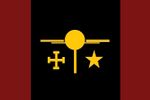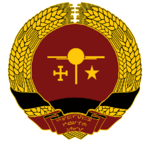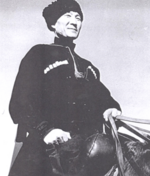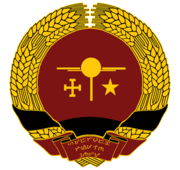National symbols of Janpia: Difference between revisions
Jump to navigation
Jump to search
mNo edit summary |
No edit summary |
||
| (11 intermediate revisions by the same user not shown) | |||
| Line 1: | Line 1: | ||
{{region_icon_Esvanovia}} | {{region_icon_Esvanovia}} | ||
{{WIP}} | |||
{|class="wikitable" | {|class="wikitable" | ||
| Line 10: | Line 11: | ||
| {{center|[[Flag of Janpia]]}} | | {{center|[[Flag of Janpia]]}} | ||
| {{center|[[File:JP.jpg|150px]]}} | | {{center|[[File:JP.jpg|150px]]}} | ||
| The Janpian flag is composed of two dark red colors symbolizing the blood | | The Janpian flag is composed of two dark red colors, with one symbolizing the blood of those who died for the revolution, and the other for the blood of her enemies. The black color symbolizes the rebirth and struggles to upheld the Revolutionary Ideals and pursuing its goal. As for its symbols, the center sun culturally symbolizes victory or Janpia itself, with the three rays of the sun signifying the motto of Janpia: Hardwork, discipline, and unity. The star on the right symbolizes the Revolutionary Ideals, while the cross on the left symbolizes the order of the Revolution. | ||
|- | |- | ||
| Emblem | | Emblem | ||
| Line 19: | Line 20: | ||
| Anthem | | Anthem | ||
| {{center|[[Forward Janpians]]}} | | {{center|[[Forward Janpians]]}} | ||
| <br> {{center|(Instrumental) <br> [[File:MediaPlayer.png|link=https://www.youtube.com/watch?v= | | <br> {{center|(Instrumental) <br> [[File:MediaPlayer.png|link=https://www.youtube.com/watch?v=mSc43KJwIB0]]}} | ||
| | | | ||
|- | |- | ||
| Line 34: | Line 35: | ||
| {{center|Janpian Maple Tree <br> (Hitomiki)}} | | {{center|Janpian Maple Tree <br> (Hitomiki)}} | ||
| {{center|[[File:Acer palmatum1.jpg|150px]]}} | | {{center|[[File:Acer palmatum1.jpg|150px]]}} | ||
| The maple | | The maple tree itself is used as a symbol of Janpia, while the falling crimson leaves were used as a symbol for the fallen revolutionaries. The cycle continues as the old leaves descend from their branches, and new ones sprout. | ||
|- | |- | ||
| rowspan="2" | National Animal | | rowspan="2" | National Animal | ||
| {{center|Raven <br> ( | | {{center|Raven <br> (Karasu)}} | ||
| {{center|[[File:Corvus corax ad berlin 090516.jpg|150px]]}} | | {{center|[[File:Corvus corax ad berlin 090516.jpg|150px]]}} | ||
| The raven symbolizes philosophy, intelligence, and wisdom, which represents the Janpian intelligentsia class during the 3rd and 4th era. | | The raven symbolizes philosophy, intelligence, and wisdom, which represents the Janpian intelligentsia class during the 3rd and 4th era. With the intelligentsia and the working class becoming one—a worker and a thinker, the raven symbolizes every Party Member. | ||
|- | |- | ||
| {{center|Masetheka Dragon}} | | {{center|Masetheka Dragon (Unofficial)}} | ||
| {{center|[[File:蛟.png|150px]]}} | | {{center|[[File:蛟.png|150px]]}} | ||
| Masetheka is a Janpian auspicious dragon known to be the founding deity of [[Schonghue]]. Its name was also the origin of the term "Mathaska", which literally means as deity in Janpian language. | | Masetheka is a Janpian auspicious dragon known to be the founding deity of [[Schonghue]]. Its name was also the origin of the term "Mathaska", which literally means as deity in Janpian language. | ||
| Line 51: | Line 52: | ||
|- | |- | ||
| National Clothing | | National Clothing | ||
| Tironov | | {{center|Tironov}} | ||
| {{center|[[File:Tironov.png|150px]]}} | | {{center|[[File:Tironov.png|150px]]}} | ||
| | | | ||
|- | |- | ||
| National Calendar | | National Calendar | ||
| [[Edict of Heavens]] | | {{center|[[Edict of Heavens]]}} | ||
| | | | ||
| | | | ||
|- | |- | ||
| National Sport | | National Sport | ||
| Kenori | | {{center|Kenori}} | ||
| {{center|[[File:Kendo EM 2005 - kote.jpg|150px]]}} | | {{center|[[File:Kendo EM 2005 - kote.jpg|150px]]}} | ||
| | |||
|- | |||
| National Mountain | |||
| {{center|[[Asentokai]] (Unofficial)}} | |||
| {{center|[[File:Marinosch-Class with Mt. Asentokai on the background.png|150px]]}} | |||
| | | | ||
|} | |} | ||
Latest revision as of 17:43, 13 October 2024
This article is incomplete because it is pending further input from participants, or it is a work-in-progress by one author. Please comment on this article's talk page to share your input, comments and questions. Note: To contribute to this article, you may need to seek help from the author(s) of this page. |
| Symbol | Name | Image | Description |
|---|---|---|---|
| Flag | The Janpian flag is composed of two dark red colors, with one symbolizing the blood of those who died for the revolution, and the other for the blood of her enemies. The black color symbolizes the rebirth and struggles to upheld the Revolutionary Ideals and pursuing its goal. As for its symbols, the center sun culturally symbolizes victory or Janpia itself, with the three rays of the sun signifying the motto of Janpia: Hardwork, discipline, and unity. The star on the right symbolizes the Revolutionary Ideals, while the cross on the left symbolizes the order of the Revolution. | ||
| Emblem | Emblem of the Janpian Union of Revolutionary Government Workers' Party
|
||
| Anthem | |||
| National Flower | Lotus Flower
(Lilyaki) |
The lotus flower symbolizes rebirth, which echoes the events during the Janpian Civil War in which the nation was reborn with struggle as a Party for the people. It also symbolizes enlightenment, mainly since the lily flowers bloom and emerge from the dark mud. | |
Red Spider Lily
(Ralilyaki) |
The Red Spider Lily is one of the two national flowers of Janpia. While the lotus flower symbolizes Janpian rebirth, the Red Spider Lily symbolizes death; completing the meaning of the Janpian flag. | ||
| National Tree | Janpian Maple Tree
(Hitomiki) |
The maple tree itself is used as a symbol of Janpia, while the falling crimson leaves were used as a symbol for the fallen revolutionaries. The cycle continues as the old leaves descend from their branches, and new ones sprout. | |
| National Animal | Raven
(Karasu) |
The raven symbolizes philosophy, intelligence, and wisdom, which represents the Janpian intelligentsia class during the 3rd and 4th era. With the intelligentsia and the working class becoming one—a worker and a thinker, the raven symbolizes every Party Member. | |
Masetheka Dragon (Unofficial)
|
Masetheka is a Janpian auspicious dragon known to be the founding deity of Schonghue. Its name was also the origin of the term "Mathaska", which literally means as deity in Janpian language. | ||
| National Instrument | Juyosche
|
||
| National Clothing | Tironov
|
||
| National Calendar | |||
| National Sport | Kenori
|
||
| National Mountain | Asentokai (Unofficial)
|












